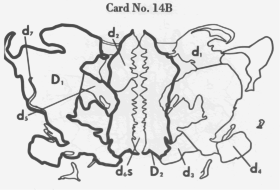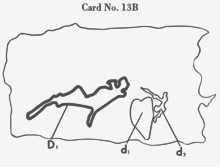Holtzman Inkblot Technique
| Holtzman Inkblot Technique | |
|---|---|
| Diagnostics | |
 From Holtzman's original 1961 "Inkblot Perception and Personality" book showing an inkblot and pointing out different areas. The text provides some example interpretations and how these are scored. | |
| MeSH | D006698 |
The Holtzman Inkblot Technique (HIT), also known as the Holtman Inkblot Test, is an inkplot test aimed at detecting personality and was conceived by Wayne H. Holtzman and colleagues. It was first introduced in 1961 as a projective personality test similar to the Rorschach. The HIT is a standardized measurement with clearly defined objective scoring criteria. The Holtzman Inkblot Test was invented as an attempt to address some controversial issues surrounding the Rorschach Inkblot Test.[1]
Precautions
The HIT is a psychometric test requiring a clinically trained examiner, and should be interpreted by a credible psychologist, psychiatrist, or a trained mental health professional. Because some find projective tests to be less reliable than objective tests the examiner must be well trained in psychometric examinations; interpretations that are subjective may affect the test.[1]
Purpose
The Holtzman Inkblot Test (HIT) was invented as an attempt to address some controversial issues surrounding the Rorschach Inkblot Test. The HIT was used to assess the personal structure of the subject.[2]
Description

The Holtzman is a standardized measurement with clearly defined objective scoring criteria. The test consists of two alternative forms of forty-five inkblots, originally drawn from a pool of several thousand. Scoring is based on twenty-two items: reaction time, rejection, location, space, form definiteness, form appropriateness, color, shading, movement, pathognomonic verbalization, integration, content (human, animal, anatomy, sexual, or abstract), anxiety, hostility, barrier, penetration, balance, and popularity. A stack of 47 cards with inkblots (45 test cards and 2 practice cards) are presented face down in front of the subject. The examiner then hands each card to the subject and asks the test subject what they see in the inkblot.[2] The examiner requests that only one response per inkblot is needed, yet, at times, the examiner may ask the subject to elaborate on a response. The HIT usually takes about 50–80 minutes. The test can also be administered to a group of patients by projecting 35-45 inkblots onto a screen and having the patients write the responses to each inkblot.[1]
Scoring
The scoring includes 22 variables covering the aspects of the patient's response to the inkblot. Many different variables apply when scoring.
- First, the variable has to be able to be scored for a legitimate response, thus becoming less theoretically possible to score ranging from 0-45 when given unitary weight.
- Second, the variable must be sufficiently objective for scoring agreement with trained individuals.
- Third, the variable must show some promise of being important to the study of personality through perception.
- Fourth, each variable must be logically independent of the others in order to code the maximum amount of information in an effective manner.[3]
22 variables and abbreviations applied[4]
| No. | Variable | Abbrev. | Description |
|---|---|---|---|
| 1 | Reaction Time | (RT) | the time in seconds from the presentation of the inkblot to the beginning of the first response |
| 2 | Rejection | (R) | score 1 when subject returns inkblot to examiner without giving a scorable response; otherwise score 0 |
| 3 | Location | (L) | tendency to break down blot into smaller fragments. score 0=use of whole blot, 1=large area, 2=smaller area |
| 4 | Space | (S) | score 1=true figure-ground reversals; score 0 otherwise |
| 5 | Form Definiteness | (FD) | the definiteness of the form of the concept reported, regardless of the goodness of fit to the inkblot. a 5 point scale with 0=very vague and 4=very specific |
| 6 | Form Appropriateness | (FA) | the goodness of fit of the form of the precept to the form of the inkblot. Score 0=poor 1=fair, 2=good |
| 7 | Color | (C) | the apparent primacy of color, including black, gray and white, as a response-determinate. score 0=no use of color, 1=secondary to form, 2=primary determinant with some form present, 3=primary determinant |
| 8 | Shading | (Sh) | the apparent primacy of shading as response determinant. 0=no use of shading, 1=secondary to form, 2=used as primary determinant but some form is present, 3= primary determinant |
| 9 | Movement | (M) | the energy level of movement or potential movement ascribed to the percept, regardless of content.0=none, 1=static potential, 2=casual, 3=dynamic, 4=violent movement |
| 10 | Pathognomic Verbalization | (V) | degree of autistic, bizarre thinking evident in the response as rated on a five scale. |
| 11 | Integration | (I) | score 1=organization of 2 or more adequately perceived blot elements into a larger whole |
| 12 | Human | (H) | degree of human quality in the content of response |
| 13 | Animal | (A) | degree of animal quality in the content |
| 14 | Anatomy | (At) | degree of "gut-like" quality in the content |
| 15 | Sex | (Sx) | degree of sexual quality in the content |
| 16 | Abstract | (Ab) | degree of abstract quality in the content |
| 17 | Anxiety | (Ax) | degree of anxiety or fantasy content as indicated by emotions and attitudes, expressive behavior, symbolism, or cultural stereotypes of fear. |
| 18 | Hostility | (Hs) | signs of hostility or fantasy content |
| 19 | Barrier | (Br) | reference to any protective covering, shell, membrane or skin that may be symbolically related to the perception of body image boundaries. |
| 20 | Penetration | (Pn) | concept that may be symbolic of an individual's feeling that his body exterior is of little protective value and can be easily penetrated |
| 21 | Balance | (B) | overt concern for the symmetry-asymmetry feature of the inkblot. |
| 22 | Popular | (P) | percept occurred at least 14% of the time among normal subjects |
Test standardization
U.S. and Mexico
The test correlations ranged from .36 for Popular and .81 for normal adults. The most stable of the inkblot scores was Location in the United States and Mexico. Reaction,Time, Form Definiteness, Movement, and Human also scored relatively high in both cultures. However, these aspects test more of the cognitive-perceptual aspects rather than personality characteristics. Rejection, Form Appropriateness, Shading, Pathognomic Verbalization, Barrier, and Penetration had lower stability coefficients while Space, Sex, Abstract and Balance proved to be extremely infrequent in the children's samples. Test results generally became more stable with age. The children showed a much weaker stability of data than that of older patients and adults possessed the greatest stability of information.[5]
See also
References
- 1 2 3 Holtzman Ink Blot Test, The Free Dictionary.
- 1 2 Holtzman, Wayne H. "Children's IQ Test: Holtzman Inkblot Test". The Psychological Corporation. Retrieved 2011-09-27.
- ↑ McRenolds, Paul (1975). Advances in Psychological Assessment. San Francisco, California: Jossey-bass Inc. p. 245. ISBN 0-87589-242-6.
- ↑ McRenolds, Paul (1975). Advances in Psychological Assessment. San Francisco, California: Jossey-bass Inc. pp. 246–247. ISBN 0-87589-242-6.
- ↑ McRenolds, Paul (1975). Advances in Psychological Assessment. San Francisco, California: Jossey-bass Inc. pp. 256–258. ISBN 0-87589-242-6.